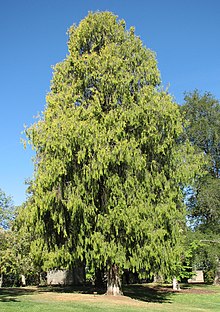Cupressus funebris
| Cupressus funebris | |
|---|---|

| |
| Scientific classification | |
| Kingdom: | Plantae |
| Clade: | Tracheophytes |
| Clade: | Gymnospermae |
| Division: | Pinophyta |
| Class: | Pinopsida |
| Order: | Cupressales
|
| Family: | Cupressaceae |
| Genus: | Cupressus |
| Species: | C. funebris
|
| Binomial name | |
| Cupressus funebris Endl. | |
| Synonyms | |
| |
Cupressus funebris, the Chinese weeping cypress, is a species of cypress native to southwestern and central China.[1] It may also occur naturally in Vietnam.[2]
Description
Cupressus funebris is a medium-sized
The leaves are scale-like, 1–2 mm long, up to 5 mm long on strong lead shoots; young trees up to about 5–10 years old have juvenile foliage with soft needle-like leaves 3–8 mm long.
The seed cones are globose, 8–15 mm long, with 6–10 scales (usually 8), green, maturing dark brown about 24 months after pollination. The cones open at maturity to shed the seed. The pollen cones are 3–5 mm long, and release pollen in early spring.

Distribution
The precise natural range of Cupressus funebris is uncertain due to a long history of cultivation. Trees are recorded from forest habitats in the provinces of Guizhou, Hunan, and Chongqing.
More generally, it also occurs in Anhui, Fujian, southern Gansu, Guangdong, Guangxi, Henan, Hubei, Jiangxi, Shaanxi, Sichuan, Yunnan, and Zhejiang, typically planted around monasteries and temples or in gardens.
Whether Cupressus funebris naturally occurs also in northern Vietnam is uncertain; if so, it probably is the most threatened conifer of that country.[2]
Cultivation
Cupressus funebris is cultivated as an
References
- ^ . Retrieved 12 November 2021.
- ^ ISBN 1-872291-64-3. Archived from the originalon 2007-05-19.
Further reading
- Farjon, A. (2005). Monograph of Cupressaceae and Sciadopitys. Royal Botanic Gardens, Kew. ISBN 1-84246-068-4

